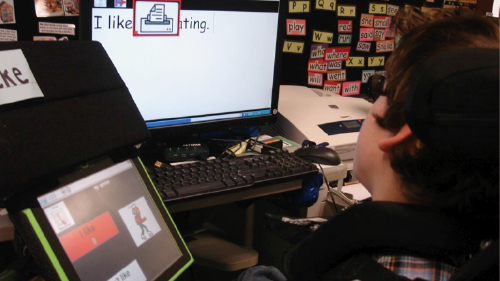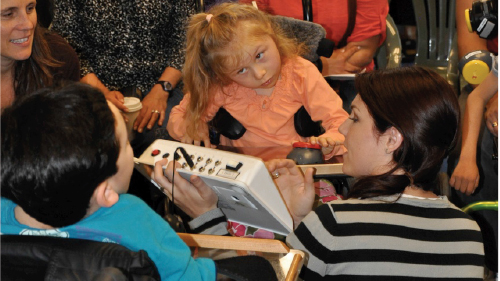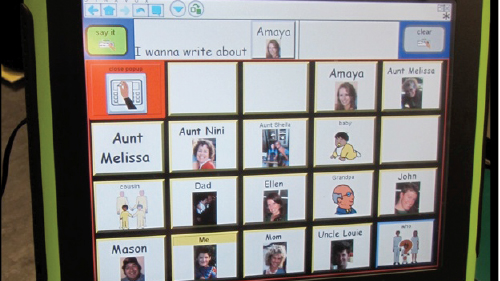Enriched Writer’s Workshop
We believe that educators can provide innovative and engaging writing experiences while working towards conventional literacy and the development of communicative competence. At The Bridge School, our elementary students (Kindergarten – 5th grade) participate in a daily Enriched Writer’s Workshop (EWW) (Sturm, 2012). Enriched Writer’s Workshop is an ideal instructional approach for students with SSPI and CCN who need to learn to write for varied purposes and audiences while concurrently learning to access and use AAC tools, strategies and devices.
Our teachers and Speech-Language Pathologists use the Enriched Writer’s Workshop lessons to incorporate student-specific AAC interventions to address communication skills and build communicative competencies with AAC Systems during the planning, composing, revising, editing, and sharing processes of writing. This is an opportunity for students to work on specific communicative competence skills in the four domains: linguistic, strategic, social, and operational.
The EWW writing routine consists of a teacher-led mini-lesson on some aspect of the writing process, craft, or workshop procedure, followed by independent writing time with peer and teacher conferences, and a spoken sharing activity where students read and share their written work and give and receive peer feedback on their writing. The core activities within the EWW routine provide an ideal instructional context for addressing key elements of communicative competence.
Operational Competence Skill
Operate an adapted word processing program, demonstrating knowledge of essential tools: print, save, open document, close document, speak/read, stop speaking.
This second grade student works on this operational skill when he independently prints his writing during EWW independent writing time. Using a customized toolbar in a specialized, switch-accessible word processor, he is learning to use his capability switch scan through the different tools and select the ‘print’ tool.
Strategic Competence Skill
Use meaningful attention-seeking signals (reaching, voice, combined) that are reliably interpreted by several partners.
This first-grade student works on this strategic competence skill while sharing her written work. Abigail practices gaining her classmate’s attention by reaching out to touch him, and by activating a simple digitized voice output device.
Social Competence Skill
Produce friendship- building messages with peers (e.g., compliments, other-focused comments, encouragement, jokes, etc.).
Abigail practices this social skill when she uses messages of praise and encouragement with another student author after they share their written work.
Linguistic Competence Skill
Combine AAC symbols meaningfully to express more complex messages by demonstrating functional use of simple slot fillers.
This second-grade student works on this linguistic skill when he selects his writing topic. Using his pre-programmed speech-generating device, Job combines two selections to produce a message ‘I want to write about + [his desired writing topic].’
In this example, he selects the messages ‘I want to write about’ and ‘Amaya’ to communicate his wish to write about his Aunt Amaya, a favorite person in his life and one of his favorite writing topics.
References
Sturm, J. (2012). An Enriched Writers’ Workshop for Beginning Writers with Developmental Disabilities. In Topics in Language Disorders, 32(4), 335-360.




